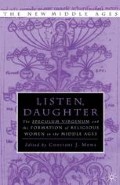Abstract
These words of the Psalmist provide a particularly appropriate way to begin thinking about the Speculum virginum [Mirror of Virgins]. Tradi-tionally interpreted as an injunction to the Church to prepare itself as a Bride to meet the Son of God, they had a particular resonance for women who sought to dedicate themselves to the religious life. The perfect soul was understood as a supremely beautiful woman who leaves her father’s house for her spiritual beloved. To a modern mind, this might seem a very alien way of imagining spiritual life. The injunction implies that God is male and that the perfect woman is fully obedient to her lover.Yet these words can also be heard as a “wake-up call,” urging rejection of worldly security and attentiveness to the voice of the Beloved. This is the way they were understood within a medieval religious environment.
Audi filia et vide et inclina aurem tuam et obliviscere populum tuum et domum patris tui et concupiscet rex decorem tuum.
[Listen, daughter, and see, and incline your ear, and forget your people and your father’s house, and the king shall desire your beauty.] Ps. 44.11–12
Access this chapter
Tax calculation will be finalised at checkout
Purchases are for personal use only
Preview
Unable to display preview. Download preview PDF.
Notes
Cindy L. Carlson and Angela Lane Weisl, “Introduction,” in Constructions of Widowhood and Virginity in the Middle Ages, ed. Carlson and Weisl, (New York: St. Martin’s Press, 1999), p. 5.
Eleanor Greenhill, Die Stellung der Handschrift British Museum Arundel 44 in der Überlieferung des Speculum virginum, Mitteilungen des Grabmann Instituts der Universität München 10 (Munich: Max HueberVerlag, 1966).
Jean Leclercq, The Love of Learning and the Desire for God: A Study of Monastic Culture, trans. Catherine Misrahi (New York: Fordham University Press, 1961), p. 60
Jean Leclercq, first published as L’Amour des lettres et le désir de Dieu. Initiation aux auteurs monastiques du moyen âge (Paris: Seuil, 1957).
Herbert Grundmann, Religious Movements in the Middle Ages: The Historical Links between Heresy, the Mendicant Orders, and the Women’s Religious Movement in the Twelfth and Thirteenth Century, with the Historical Foundations of German Mysticism, trans. Steven Rowan (Notre-Dame, IN: University of Notre-Dame Press, 1995).
For an excellent collection of recent studies, see Juliette Dor, Lesley Johnson and Jocelyn Wogan-Browne, eds., New Trends in Feminine Spirituality: The Holy Women of Liège and Their Impact (Turnhout: Brepols, 1999).
See the different chapters in David Townsend and Andrew Taylor, eds., The Tongue of the Fathers: Gender and Ideology in Twelfth-Century Latin (Philadelphia: University of Pennsylvania Press, 1998).
Penelope Johnson, “The Cloistering of Medieval Nuns: Release or Repression, Reality or Fantasy” in Gendered Domains: Rethinking Public and Private in Women’s History ed. Dorothy O. Helly and Susan M. Reverby (Ithaca, NY: Cornell University Press, 1992), pp. 27–39; see also chapter 3 by Julie Hotchin below.
Constance H. Berman, “Were There Twelfth-Century Cistercian Nuns?” Church History: Studies in Christianity and Culture 68 (1999): 824–64.
See also John A. Nichols and Lillian Shank, eds., Hidden Springs: Cistercian Monastic Women Cistercian Studies Series 113A–113B (Kalamazoo, MI: Cistercian Publications, 1995), vols. 1–2.
Einar Mar Jonsson, Le Miroir: Naissance d’un genre littéraire (Paris: Les Belles Lettres, 1995).
Constant J. Mews, The Lost Love Letters of Heloise and Abelard: Perceptions of Dialogue in Twelfth-Century France (New York: St. Martin’s Press, 1999).
Jeffrey Hamburger, Nuns as Artists:The Visual Culture of a Medieval Convent (Berkeley: University of California Press, 1997)
Jeffrey Hamburger, The Visual and the Visionary: Art and Female Spirituality in Late Medieval Germany (New York: Zone Books, 1998).
Editor information
Copyright information
© 2001 Constant J. Mews
About this chapter
Cite this chapter
Mews, C.J. (2001). Introduction. In: Mews, C.J. (eds) Listen, Daughter. The New Middle Ages. Palgrave Macmillan, New York. https://doi.org/10.1007/978-1-137-07943-5_1
Download citation
DOI: https://doi.org/10.1007/978-1-137-07943-5_1
Publisher Name: Palgrave Macmillan, New York
Print ISBN: 978-1-349-63327-2
Online ISBN: 978-1-137-07943-5
eBook Packages: Palgrave Literature & Performing Arts CollectionLiterature, Cultural and Media Studies (R0)

